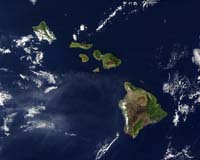 |
Nottingham UK (SPX) May 23, 2011 The genetic 'wiring' that helps a seed to decide on the perfect time to germinate has been revealed by scientists for the first time. Plant biologists at The University of Nottingham have also discovered that the same mechanism that controls germination is responsible for another important decision in the life cycle of plants - when to start flowering. Their discovery throws light on the genetic mechanisms that plants use to detect and respond to vital environmental cues and could be a significant step towards the development of new crop species that are resistant to climate change and would help secure future food supplies. Seeds in the soil sense a whole range of environmental signals including temperature, light, moisture and nutrients, when deciding whether to germinate or to remain dormant. To ensure that the decision for a seed to germinate is made at the perfect moment to ensure survival, evolution has genetically 'wired' seeds in a very complex way to avoid making potentially deadly mistakes. The breakthrough has been made by scientists at Nottingham's Division of Crop and Plant Sciences who collaborate within one of the University's Research Priority Groups, Global Food Security. The team compiled publicly available gene expression data and used a systematic statistical analysis to untangle the complex web of genetic interactions in a model plant called Arabidopsis thaliana or thale cress. The plant is commonly used for studying plant biology as changes in the plant are easily observed and it was the first plant to have its entire genome sequenced. The resulting gene network - or SeedNet as it was dubbed - highlighted what little scientists already know about the regulation of seed germination while being able to predict novel regulators of this process with remarkable accuracy. The work was led by Dr George Bassel who joined The University of Nottingham on an NSERC PDF fellowship from the Canadian government to work with Professor Mike Holdsworth on research into seed germination. He has since been awarded a prestigious Marie Curie International Incoming Fellowship. Dr Bassel said: "To our surprise, the seed network demonstrated that genetic factors controlling seed germination were the same as those controlling the other irreversible decision in the life cycle of plants: the decision to start flowering. The induction of flowering, like germination, is highly responsive to cues from the environment." Another key finding from SeedNet was that the same genes that leaves and roots use to respond to stress are used by seeds to stop their germination. Given that seeds were evolved long after plants developed their ability to withstand environmental stress, this indicated that plants have adapted existed genes to fulfil a different role. The work could lead to identifying important factors controlling stress response in seeds and the plant itself, contributing towards the development of new crops producing increased yields under extreme environmental conditions such as drought or floods. The work is being published in the Proceedings of the National Academy of Sciences Online Early Edition this week.
Share This Article With Planet Earth
Related Links University of Nottingham Farming Today - Suppliers and Technology
 Patterns Of Ancient Croplands Give Insight Into Early Hawaiian Society
Patterns Of Ancient Croplands Give Insight Into Early Hawaiian SocietyColumbus OH (SPX) May 23, 2011 A pattern of earthen berms, spread across a northern peninsula of the big island of Hawaii, is providing archeologists with clues to exactly how residents farmed in paradise long before Europeans arrived at the islands. The findings suggest that simple, practical decisions made by individual households were eventually adopted by the ruling class as a means to improve agricultural productiv ... read more |
|
| The content herein, unless otherwise known to be public domain, are Copyright 1995-2010 - SpaceDaily. AFP and UPI Wire Stories are copyright Agence France-Presse and United Press International. ESA Portal Reports are copyright European Space Agency. All NASA sourced material is public domain. Additional copyrights may apply in whole or part to other bona fide parties. Advertising does not imply endorsement,agreement or approval of any opinions, statements or information provided by SpaceDaily on any Web page published or hosted by SpaceDaily. Privacy Statement |